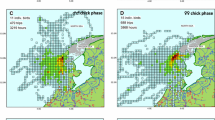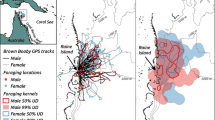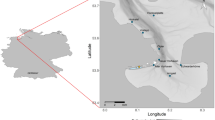Abstract
Reversed sexual dimorphism (RSD) may be related to different roles in breeding investment and/or foraging, but little information is available on foraging ecology. We studied the foraging behaviour and parental investment by male and female masked boobies, a species with RSD, by combining studies of foraging ecology using miniaturised activity and GPS data loggers of nest attendance, with an experimental study where flight costs were increased. Males attended the chick more often than females, but females provided more food to the chick than males. Males and females foraged during similar periods of the day, had similar prey types and sizes, diving depths, durations of foraging trips, foraging zones and ranges. Females spent a smaller proportion of the foraging trip sitting on the water and had higher diving rate than males, suggesting higher foraging effort by females. In females, trip duration correlated with mass at departure, suggesting a flexible investment through control by body mass. The experimental study showed that handicapped females and female partners of handicapped males lost mass compared to control birds, whereas there was no difference for males. These results indicate that the larger female is the main provisioner of the chick in the pair, and regulates breeding effort in relation to its own body mass, whereas males have a fixed investment. The different breeding investment between the sexes is associated with contrasting foraging strategies, but no clear niche differentiation was observed. The larger size of the females may be advantageous for provisioning the chick with large quantities of energy and for flexible breeding effort, while the smaller male invests in territory defence and nest guarding, a crucial task when breeding at high densities. In masked boobies, division of labour appears to be maximal during chick rearing—the most energy-demanding period—and may be related to evolution of RSD.








Similar content being viewed by others
References
Anderson DJ, Ricklefs RE (1992) Brood size and food provisioning in masked and blue-footed boobies (Sula spp.). Ecology 73:1363–1374
Andersson M (1994) Sexual selection. Princeton University Press, Princeton
Andersson M, Norberg RÅ (1981) Evolution of reversed sexual size dimorphism and role partitioning among predatory birds, with a size scaling of flight performance. Biol J Linn Soc 15:105–130
Boggs CL (1992) Resource allocation, exploring connections between foraging and life histories. Functl Ecol 6:508–518
Catry P, Phillips RA, Furness RW (1999) Evolution of reversed sexual size dimorphism in skuas and jaegers. Auk 116:158–168
Chaurand T, Weimerskirch H (1994) The regular alternation of short and long trips in the Blue petrel Halobaena caerulea, a previously undescribed strategy of food provisioning in a pelagic seabird. J Anim Ecol 63:275–282
Clarke MR (1986) A handbook for the identification of cephalopods beaks. Clarendon, Oxford
Cuthill I (1991) Field experiments in animal behaviour, methods and ethics. Anim Behav 42:1007–1014
Drent RH, Daan S (1980) The prudent parent, energetic adjustment in avian breeding. Ardea 68:225–252
Erikstad KE, Fauchald P, Tveera T, Steen H (1998) On the cost of reproduction in long-lived birds: the influence of environmental variability. Ecology 79:1781–1788
Fairbairn J, Shine R (1993) Patterns of sexual size dimorphism in seabirds of the southern hemisphere. Oikos 68:139–145
Fauchald P, Tveraa T (2003) Using first-passage time in the analysis of area-restricted search and habitat selection. Ecology 84:282–288
Gilardi JD (1992) Sex-specific foraging distributions of brown boobies in the eastern tropical Pacific. Colon Wat 15:148–151
Gonzales-Solis J, Croxall JP, Wood AG (2000) Sexual dimorphism and sexual segregation in foraging strategies of northern giant petrels Macronectes halli during incubation. Oikos 90:390–398
Gray CM, Hamer KC (2001) Food-provisioning behaviour of male and females Manx shearwaters. Anim Behav 62:117–121
Guerra M, Drummond H (1995) Reversed sexual size dimorphism and parental care : minimal division of labour in the blue-footed booby. Behaviour 132:479–496
Hertel F, Ballance LT (1999) Wing ecomorphology of seabirds from Johnston Atoll. Condor 101:549–556
Hyrenbach KD, Fernandez P, Anderson DJ (2002) Oceanographic habitats of two sympatric North Pacific albatrosses during their breeding season. Mar Ecol Prog Ser 233:283–301
Jehl JR Jr, Murray BG Jr (1986) The evolution of normal and reverse sexual size dimorphism in shorebirds and other birds. In: Johnston RF (ed) Current ornithology, vol 3. New York, Plenum, pp 1–86
Le Corre M, Cherel Y, Lagarde F, Lormée H, Jouventin P (2003) Seasonal and inter-annual variation in the feeding ecology of a tropical oceanic seabird, the red-tailed tropicbird Phaethon rubricauda. Mar Ecol Progr Ser 255:289–301
Lewis S, Benvenuti S, Dall’Antonia L, Griffiths R, Money L, Sherratt TN, Wanless S, Hamer KC (2002) Sex-specific foraging behaviour in a monomorphic seabird. Proc R Soc Lond B Biol Sci 269:1687–1693
Lewis S, Schreiber EA, Daunt F, Schenk GA, Wanless S, Hamer KC (2004) Flexible foraging patterns under different time constraints in tropical boobies. Anim Behav 68:1331–1337
Lewis S, Schreiber EA, Daunt F, Schenk GA, Orr K, Adams A, Wanless S, Hamer KC (2005) Sex-specific foraging behaviour in tropical boobies: does size matter? Ibis 147:408–414
Lind J, Jakobsson S (2001) Body building and concurrent mass loss: flight adaptations in tree sparrows. Proc R Soc Lond B Biol Sci 268:1915–1919
Lormée H, Jouventin P, Lacroix A, Lallemand J, Chastel O (2000) Reproductive endocrinology of tropical seabirds, sex specific patterns in LH, steroids and prolactin secretion in relation to parental care. Gen Comp Endocrinol 117:413–426
Lormée H, Barbraud C, Chastel O (2005) Reversed sexual size dimorphism and parental care in the Red-footed booby (Sula sula). Ibis 147:307–315
Lundberg A (1986) Adaptive advantages of reversed sexual dimorphism in European owls. Ornis Scand 17:133–140
Mauck RA, Grubb TC Jr (1995) Petrel parents shunt all experimentally increased reproductive costs to theor offspring. Anim Behav 49:999–1008
Monaghan P, Uttley JD, Burnes MD, Thaine C, Blackwood J (1989) The relationship between food supply, reproductive effort and breeding success in Arctic terns Sterna paradisae. J Anim Ecol 58:261–274
Mueller HC (1990) The evolution of reversed sexual dimorphism in size in monogamous species of birds. Biol Rev 65:553–585
Nelson B (1978) The Sulidae: gannets and boobies. Oxford University Press, Oxford
Nesis KN (1987) Cephalopods of the World. Squids, cuttlefishes, octopuses and allies. TFH Publications, Neptune City, NJ
Newton I (1979) Population ecology of raptors. Poyser, Berkhamsted
Pennycuick CJ (1989) Bird flight performance: a practical calculation manual. Oxford Science Publications, Oxford University Press, Oxford
Phillips RA, Silk JRD, Phalan B, Catry P, Croxall JP (2004) Seasonnal sexual segregation in two Thallassarche albatross species: competitive exclusion, reproductive role specialization or foraging niche divergence. Proc R Soc Lond B Biol Sci 271:1283–1291
Pinaud D (2008) Quantifying search effort of moving animals at different spatial scales using first passage time analysis: effect of structure of the environment and tracking system. J Appl Ecol 45:91–99
Reznick D (1985) Cost of reproduction: an evaluation of empirical evidence. Oikos 44:247–267
Ricklefs RE (1987) Response of adult Leach’s storm petrel to increase food demand at nest. Auk 104:750–756
Ricklefs RE (1983) Some considerations on the reproductive energetic of pelagic seabirds. Stud Avian Biol 8:84–94
Ropert-Coudert Y, Grémillet D, Ryan P, Kato A, Naito Y, Le Maho Y (2004) Between air and water, the plunge dive of the Cape Gannet Morus capensis. Ibis 146:281–290
Saether BE, Andersen R, Pedersen HC (1993) Regulation of parental effort in a long-lived seabird: an experimental manipulation of the costs of reproduction in Antarctic petrels Thalassoica antarctica. Behavl Ecol Sociobiol 33:147–150
Sato K, Watanuki Y, Takahashi A, Miller PJO, Tanaka H, Kawabe R, Ponganis PJ, Handrich Y, Akamatsu T, Watanabe Y, Mitani Y, Costa DP, Bost CA, Aoki K, Amano M, Trathan P, Shapiro A, Naito Y (2007) Stroke frequency, but not swimming speed, is related to body size in free-ranging seabirds, pinnipeds and cetaceans. Proc R Soc London B Biol Sci 274:471–477
Seaman DE, Powell RA (1996) An evaluation of the accuracy of kernel density estimators for home range analysis. Ecology 77:2075–2085
Shaffer SA, Weimerskirch H, Costa DP (2001) Functional significance of sexual dimorphism in Wandering albatrosses Diomedea exulans. Functl Ecol 15:203–210
Shine R (1989) Ecological causes for the evolution of sexual dimorphism, a review of the evidence. Q Rev Biol 64:419–461
Simmons KEL (1970) Ecological determinants of breeding adaptations and social behaviour in two fish-eating birds. In: Crook JH (ed) Social behaviour in birds and mammals. Academic, London, pp 37–77
Smith MM, Heemstra PC (1986) Smith’s sea fishes. Springer, New York
Stearns SC (1992) The evolution of life histories. Oxford University Press, Oxford
Steiner I, Bürgi C, Werffeli S, Dell’Omo G, Valenti P, Tröster G, Wolfer DP, Lipp HP (2000) A GPS logger and software for analysis of homing in pigeons and small mammals. Physiol Behav 71:589–596
Tershy BR, Croll DA (2000) Parental investment, adult sex ratios, and sexual selection in a socially monogamous seabird. Behav Ecol Sociobiol 48:52–60
Velando A (2002) Experimental manipulation of parental effort produces differential effects in sons and daughters, implications for adaptive sex ratios in blue-footed boobies. Behav Ecol 13:443–449
Velando A, Alonso-Alvarez C (2003) Differential body condition regulation by males and females in response to experimental manipulations of brood size and parental effort in the blue-footed booby. J Anim Ecol 72:846–856
Watanuki Y, Niizuma Y, Gabrielsen GW, Sato K, Naito Y (2003) Stroke and glide of wing-propelled divers, deep diving seabirds adjust surge frequency to buoyancy change with depth. Proc R Soc London B Biol Sci 270:483–488
Weimerskirch H (1999) The role of body condition in breeding and foraging decisions in albatrosses and petrels. In: Adams NJ, Slotow RH (eds) Proceedings of the 22nd International ornithological congress, Johannesburg: Birdlife South Africa, Durban, pp 1178–1189
Weimerskirch H, Fradet G, Cherel Y (1999) Natural and experimental changes in provisioning in a long-lived seabird, the Antarctic Prion. J Avian Biol 30:165–174
Weimerskirch H, Guionnet T, Martin J, Shaffer SA, Costa DP (2000) Fast and fuel efficient? Optimal use of wind by flying albatrosses. Proc R Soc London B Biol Sci 267:1869–1874
Weimerskirch H, Prince PA, Zimmermann L (2001) Influence of environmental variability on breeding effort in a long-lived seabird, the yellow-nosed albatross? Behav Ecol 12:22–30
Weimerskirch H, Le Corre M, Ropert-Coudert Y, Kato A, Marsac F (2005) The three-dimensional flight of red-footed boobies: adaptations to foraging in a tropical environment. Proc R Soc London B Biol Sci 272:53–61
Weimerskirch H, Le Corre M, Ropert-Coudert Y, Kato A, Marsac F (2006) Sex-specific foraging behaviour in a seabird with reversed sexual dimorphism, the red-footed booby. Oecologia 146:681–691
Weimerskirch H, Pinaud D, Pawlowski F, Bost CA (2007) Does prey capture induce area-restricted search? A fine scale study using GPS in a marine predator, the wandering albatross. Am Nat 170:734–743
Weimerskirch H, Le Corre M, Bost CA (2008) Foraging strategy of masked boobies from the largest colony in the world: relation with environmental conditions and fisheries? Mar Ecol Prog Ser 362:291–302
Williams GC (1966) Natural selection, the cost of reproduction and a refinement of lack’s principle. Am Nat 100:687–690
Wood AG, Naef-Daenzer P, Prince PA, Croxall JP (2000) Quantifying habitat use in satellite tracked pelagic seabirds: application of the kernel estimation to albatross locations. J Avian Biol 31:278–286
Worton BJ (1995) Using Monte Carlo simulation to evaluate kernel-based home range estimators. J Wildl Manage 59:794–800
Acknowledgments
We would like to address our special thanks to Dr. Jean Louis Etienne for organising the expedition to Clipperton Island, and for the logistical and financial support of the study. We thank the Conseil Régional Poitou Charentes, Université de la Réunion for additional financial support. We also extend our gratitude to all the participants of the expedition for their help during the fieldwork. We finally thank S. Ruault for molecular sexing of the boobies. We thank R. Mullers and Lisa T. Ballance for extensive comments and suggestions on an earlier version of the manuscript.
Author information
Authors and Affiliations
Corresponding author
Additional information
Communicated by Anssi Laurila.
Rights and permissions
About this article
Cite this article
Weimerskirch, H., Le Corre, M., Gadenne, H. et al. Relationship between reversed sexual dimorphism, breeding investment and foraging ecology in a pelagic seabird, the masked booby. Oecologia 161, 637–649 (2009). https://doi.org/10.1007/s00442-009-1397-7
Received:
Accepted:
Published:
Issue Date:
DOI: https://doi.org/10.1007/s00442-009-1397-7




